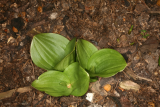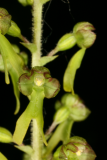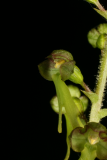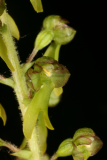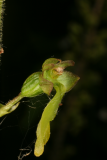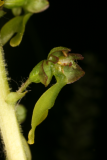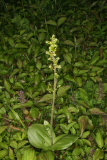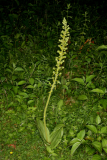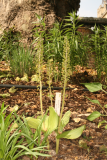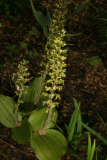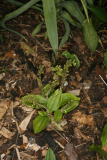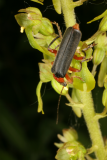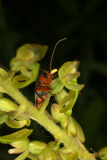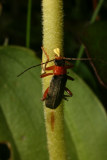Additional notes (click to expand)
Commemorative
Previously known as Listera ovata a rather dull European orchid. It was named after Dr Martin Lister FRCP FRS (1639–1712), physician to Queen Anne. He was born in Buckinghamshire, gained an arts degree at St John’s College, Cambridge, in 1658, and then an MA in 1662. He studied medicine, travelling in France until 1670, and on his return set up practice in York. He was much involved with natural history and antiquities, and was elected FRS in November 1671. His Historiae conchyliorum, published in 1685 (an encyclopaedia of shells with 1,000 drawings made by his daughters Susanna and Mary), was regarded as opening a new era in the science of conchology. He decided to move to London, and was created a doctor of medicine at Oxford in 1683. He was admitted as a candidate of the (Royal) College of Physicians in 1684 and created a fellow in 1687. He served as a censor at the (Royal) College of Physicians in 1694. He became physician to Queen Anne, Queen of England (Scotland, Ireland and France) who reigned
1702–14, in 1709. He wrote papers on subjects from spiders to geology which were published in the Proceedings of the Royal Society.
He invented the histogram!
Oakeley, Dr. Henry. (2012). Doctors in the Medicinal Garden. Plants named after physicians. Royal College of Physicians.
link
Medicinal
Historical Note: Praefertur universa planta deigrandos capillos, fracturas sanandas, & vulnera glutinanda. [.. the whole plant to blacken hair, heal fractures and seal wounds]
Matthioli, Petri Andreae, Camerario, Ioachimo, Calceolario, Francisco. (1586). De Plantis Epitome Utilissima. Francofurti ad Moenum. p.943
Nomenclature
This orchid first appeared as Ophris in Leonard Fuchs’ herbal, De Historia Stirpium (1542), and as 'Twayblade’ in Henry Lyte’s translation of Dodoens’ A Nievve Herball (1578). Dodoens grouped it with the bird’s nest orchid Neottia nidus-avis; Linnaeus called it Ophrys ovata (1753), but recently taxonomists have agreed with Dodoens and have re-classified it as Neottia ovata.
Oakeley, Dr. Henry. (2011). A Year in the Medicinal Garden of the Royal College of Physicians, revised edition. Royal College of Physicians, London.
link
Ophris. In Italy: Ellebore bianco falso. In Germany: Bweiblatt. With good woodcut.
Matthioli, Petri Andreae, Camerario, Ioachimo, Calceolario, Francisco. (1586). De Plantis Epitome Utilissima. Francofurti ad Moenum. Page 943
Syn. = Listera ovata. Neottia ovata is the accepted name (2014)
World Checklist of Monocotyledons. Royal Botanic Gardens, Kew at www.kew.org/wcsp/monocots
Other use
This rather dull, green-flowered orchid is found throughout northern Europe and Asia and in North America (on an island in Lake Huron, Ontario). It grows in great numbers in open fields and light woodland, where it is pollinated by Cantharis rufipes beetles. It was used for treating wounds and ruptures (Dodoens, Fuchs, Johnson) but does not appear in modern medical herbals. Robert Brown named it after Dr Martin Lister FRCP (1638–1712), physician to Queen Anne (see Munk’s Roll vol 1: 442 (1878)). He published a description of around 1,000 shells in 1685, and numerous papers on spiders and geology as well as making significant contributions to the Ashmolean Museum. His orchid first appeared as Ophris in Leonard Fuchs’ herbal De Historia Stirpium (1542) and as 'Twayblade’ in Henry Lyte’s translation of Dodoens’ A nievve herball (1578). Dodoens grouped it with the bird’s nest orchid Neottia nidus-avis; Linnaeus called it Ophrys ovata (1753), but recently taxonomists have agreed with Dodoens and have re-classified it as Neottia ovata.
Oakeley, Dr. Henry. (2011). A Year in the Medicinal Garden of the Royal College of Physicians, revised edition. Royal College of Physicians, London.
link
Neottia ovata (L.) Bluff & Fingerh.
Family: ORCHIDACEAEGenus: Neottia
Species: ovata (L.) Bluff & Fingerh.
Common names: Twayblade; Bifoil; Double Leaf; Heart-Leaf Twayblade
Distribution summary: Europe to Himalayas
Habit: Perennial
Hardiness: H5 - Hardy; cold winter
Garden status: Currently grown
Garden location: North America (A)
Flowering months: May
Reason for growing: Medicinal
